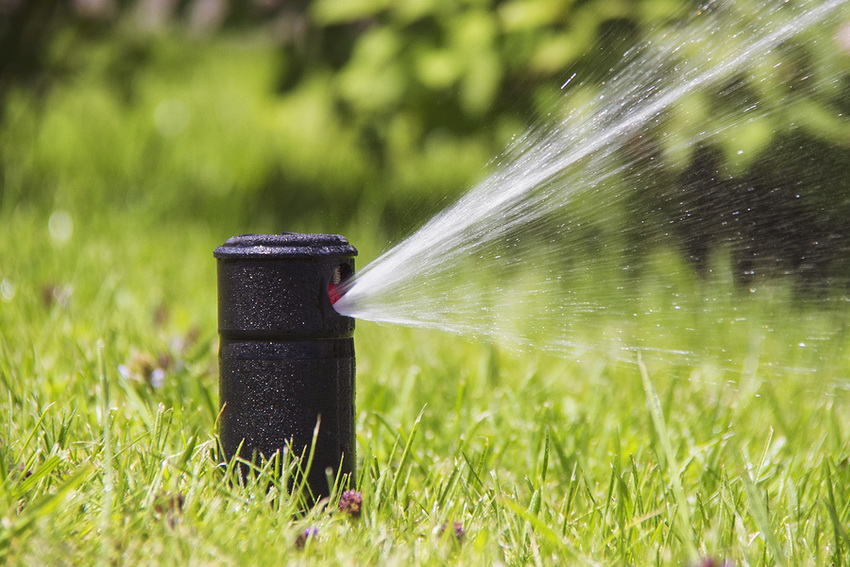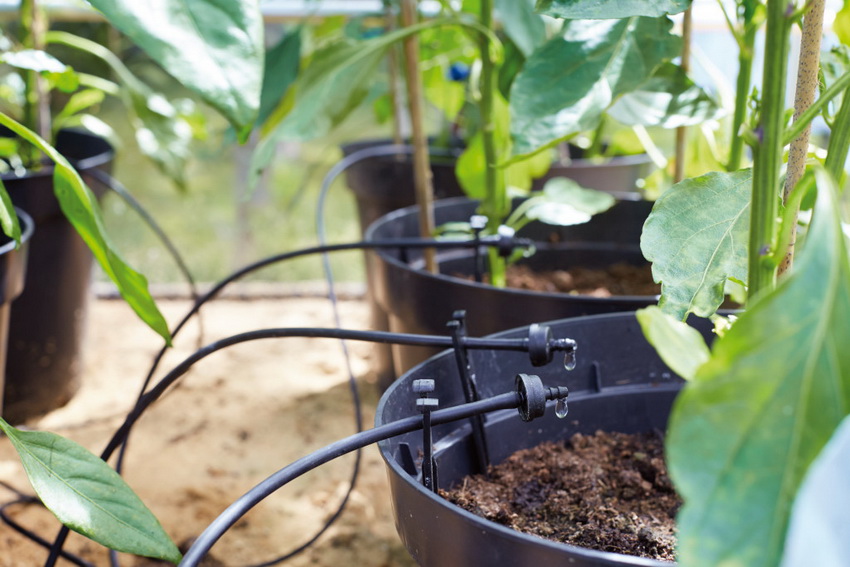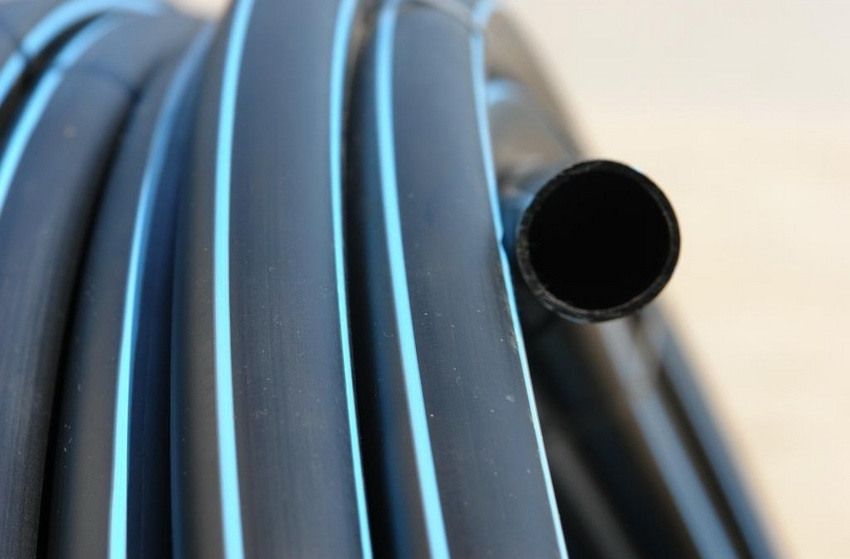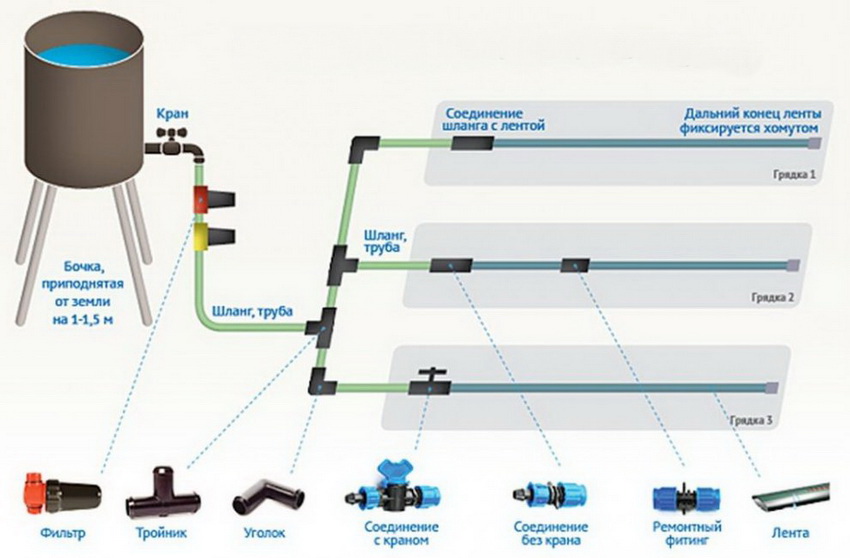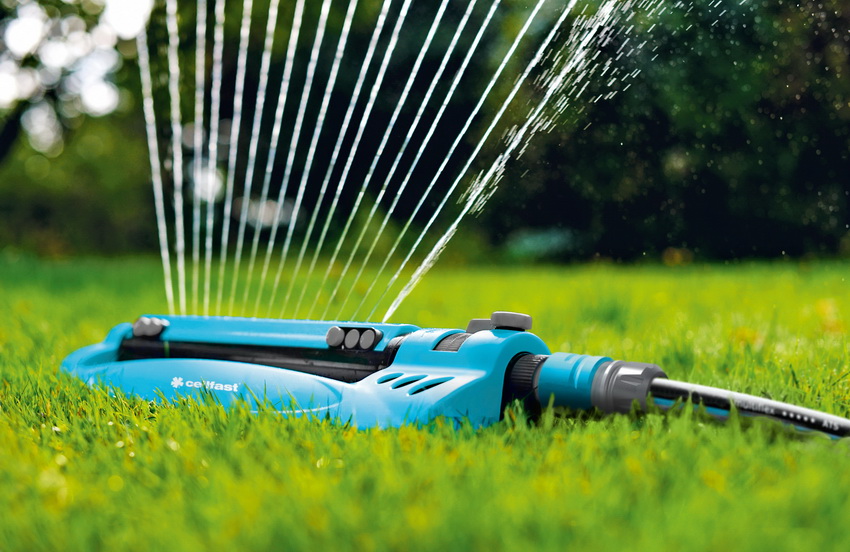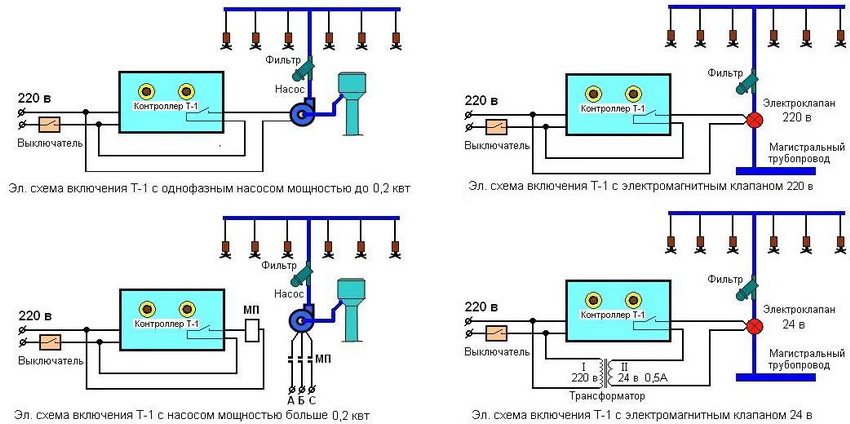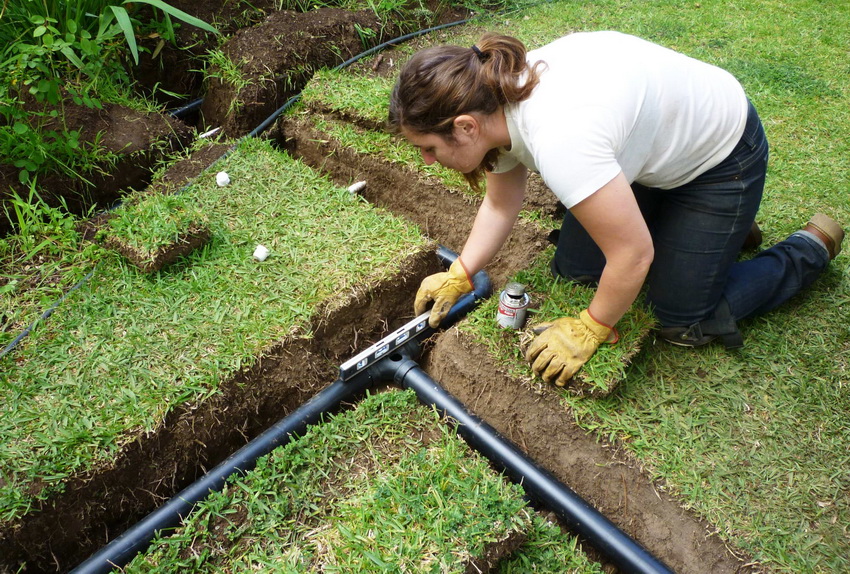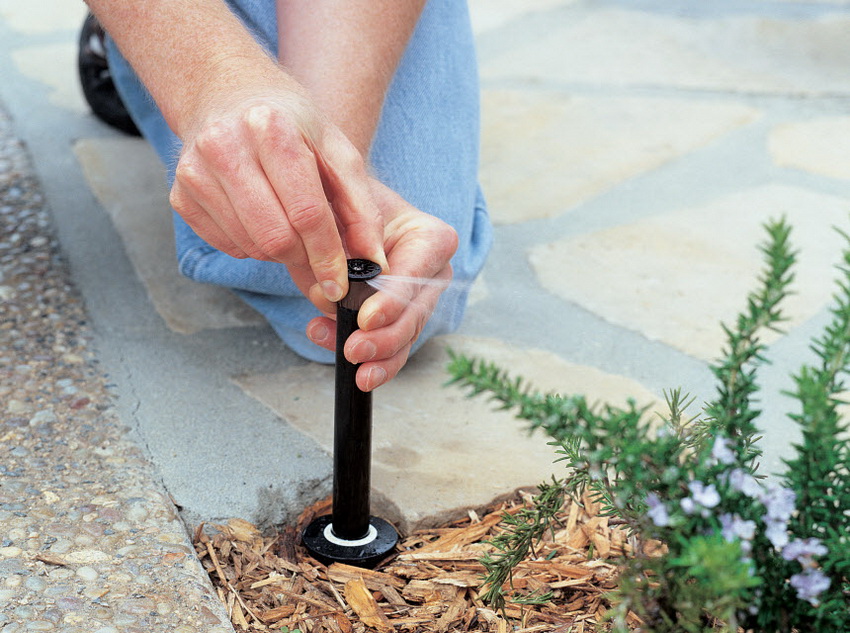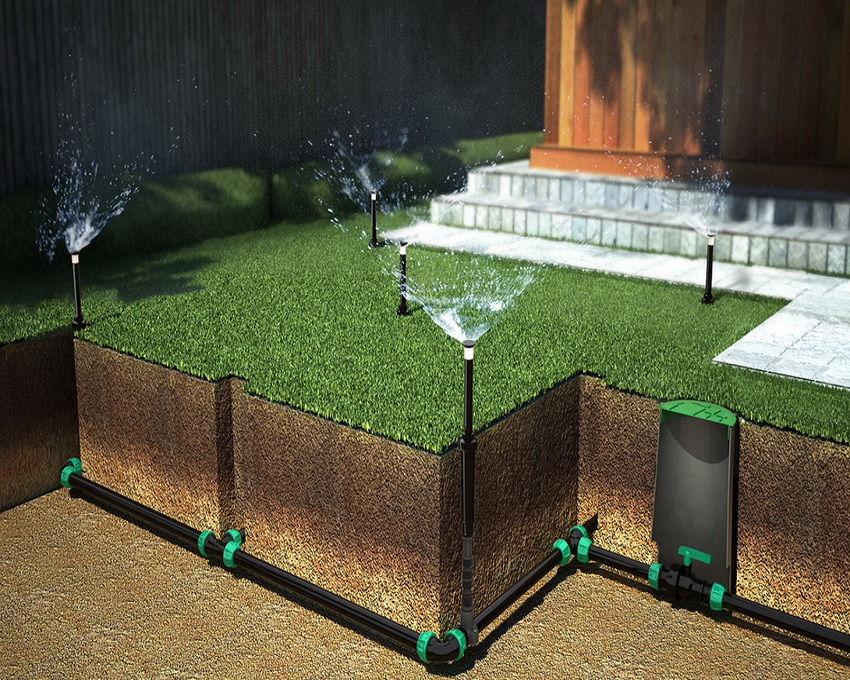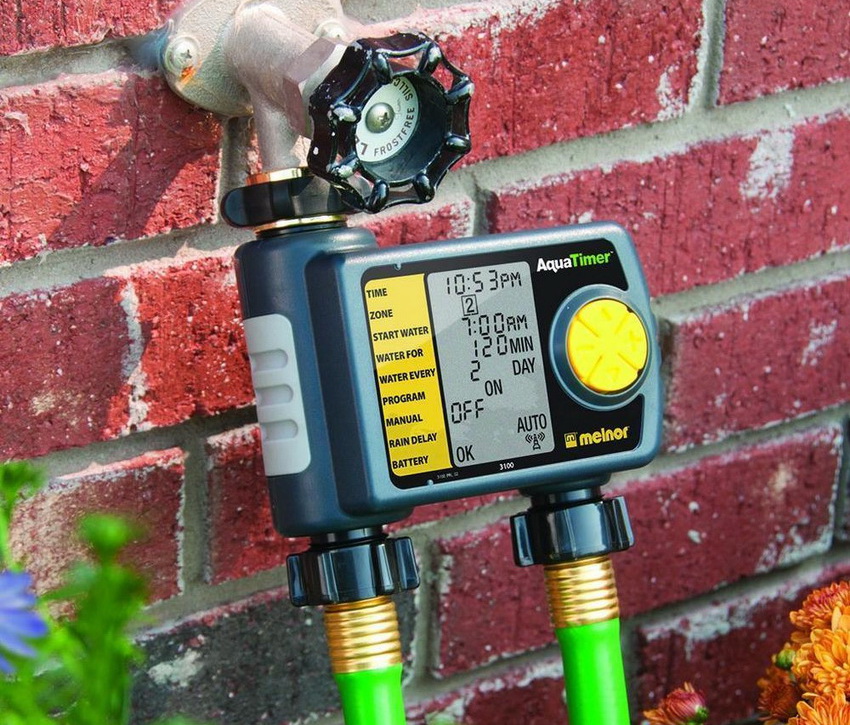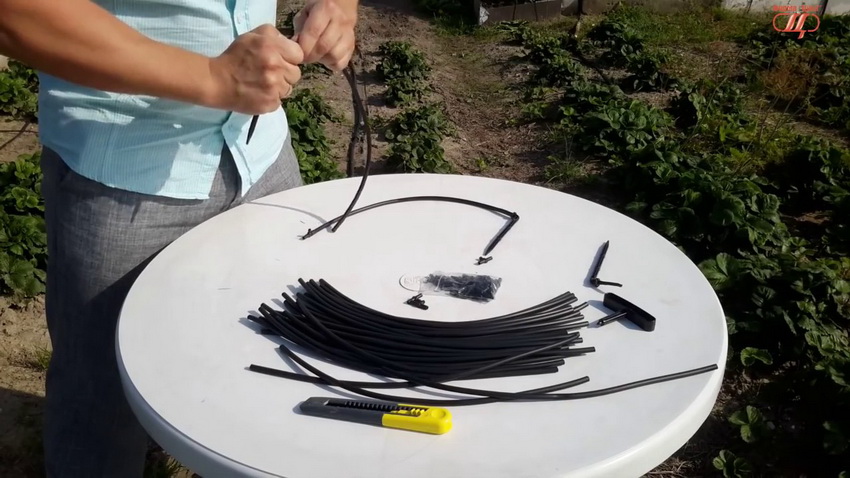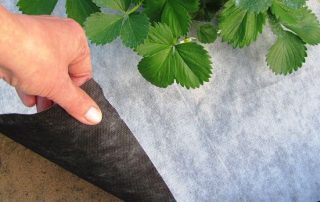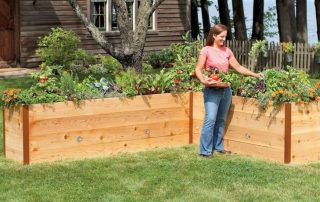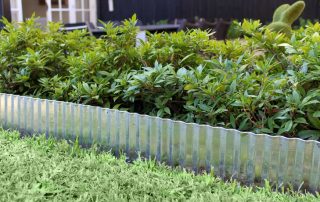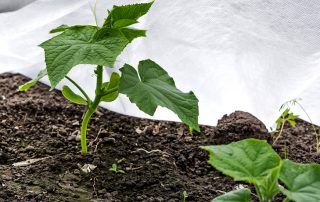Caring for a summer cottage, greenhouse, flower bed or lawn takes a lot of time and effort. For maximum optimization of labor, you can organize self-watering with your own hands, while choosing the necessary irrigation system. The automatic system provides uniform and regular watering to reduce water consumption, increase yields and improve plant appearance. How to organize it correctly, depending on the type chosen, is described in this article.
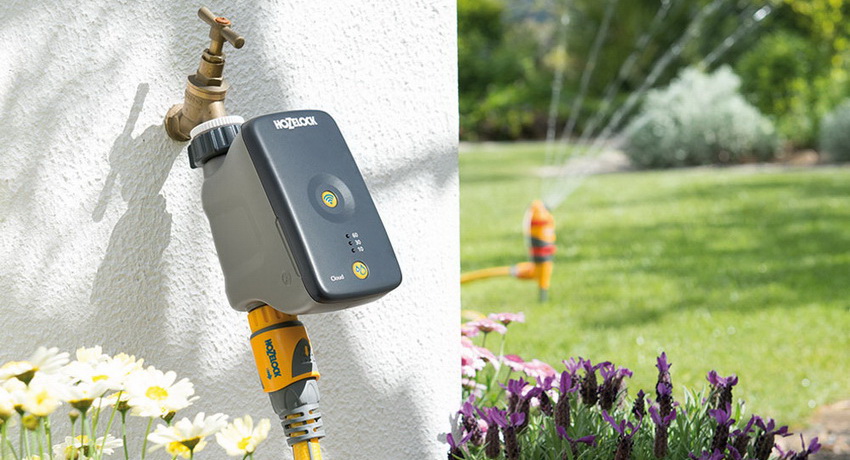
Installation of an automatic irrigation system will allow irrigation of the site on a schedule without additional user intervention
Content [Hide]
- 1 Features of the autowatering system in the country
- 2 Controller and timer for automatic garden irrigation system
- 3 Filters and water tank for organizing automatic irrigation
- 4 Selecting a pump unit for autowatering
- 5 Selection of pipelines for organizing an automated irrigation system in the country
- 6 Varieties of automatic watering schemes for the garden
- 7 Features of rain automatic irrigation
- 8 Drip irrigation as a type of automatic irrigation system in the country
- 9 Organization of subsoil watering for the garden
- 10 Which is better to buy automatic irrigation for greenhouses: an overview of popular kits
Features of the autowatering system in the country
Auto-irrigation of a plot is a special technical complex that provides uniform and regular water supply to plants in a certain area. The system can be classified as landscape irrigation. It consists of hoses, sprinklers, taps, a pump, various valves and a controller, which operates on the basis of a set program. Automatic irrigation works according to the schedule entered in the control program.
The so-called "smart rain" system is often used in winter gardens, parks, greenhouses, industrial greenhouses. It is also installed in a summer cottage of any size, so that you can control the watering of the garden, lawn, garden and flower beds.
Among the main advantages of the do-it-yourself autowatering system in the country are the following:
- ease of use;
- no need for self-watering plants in a summer cottage or greenhouse;
- the ability to set the required intensity and frequency of watering;
- automatic irrigation reacts sharply to the humidity of the environment, so the system will automatically turn off when it rains, which will save water;
- the ability to install the system by the clock and in a certain area of the garden or greenhouse;
- durability.
The autowatering system can be of three types: sprinkling, drip irrigation and subsurface irrigation - each of the options has distinctive features and is selected based on the nature of the site and the types of green spaces.

Installing an automatic irrigation system on the site will save the owners a lot of time and effort spent on self-watering plants
Controller and timer for automatic garden irrigation system
Watering can be semi-automated and fully automated. The first option involves the installation of automatic watering timers, which are represented by electrical or electromechanical devices that allow you to set the duration and frequency of irrigation.
Fully automated do-it-yourself autowatering systems are equipped with a controller. This is the so-called brain of the device, represented by a mini-computer, thanks to which the entire system works. Based on the set program, the controller controls the device, regulates the number of irrigations and the intensity of the pressure, controls the pressure in the network and the temperature of the water. It has a built-in humidity sensor that is sensitive to rain. It automatically shuts down the system if necessary. The controller can be installed indoors and outdoors.
Important! To organize the timely supply of water to the sprinklers and pipes, an electromagnetic valve is used.
Many modern controllers are equipped with GSM-modules, thanks to which the system can be controlled from a mobile phone. Timers and controllers have a different number of channels. To irrigate plants of the same type, which have the same irrigation regime, devices with one channel are sufficient. For different irrigation options, you will need multi-channel devices.
Useful advice! You can purchase several single-channel simple devices and connect them to one line, while setting different irrigation programs.
When choosing automation for the irrigation system, you should pay attention to the type of battery and the autonomy of the device. Most devices use multiple AA batteries or one 9V battery.
Filters and water tank for organizing automatic irrigation
Any irrigation system starts with a water source. In most cases, when organizing an automated irrigation system in the country with your own hands, a metal or plastic container for water of different volumes is used. Direct connection of the system to a centralized water supply system is undesirable, since it may contain too cold water, which can harm the plants. The presence of an intermediate tank will allow the water to warm up to air temperature. In addition, the tank acts as a reserve tank, which will come in handy in case of a water outage.
Useful advice! For the organization of drip irrigation, it is recommended to install the container on a small hill, due to which the system will create pressure sufficient for its operation.
The water supply to the tank should be from the top, which will make it possible to fill the container to the top. The water intake is stirred at its lowest point, but not at the very bottom, as this will contribute to the accumulated debris entering the system. But for possible cleaning of the container, place a tap designed to drain water should be located in the bottom of the product.
Useful advice! It is possible to organize the flow of rainwater from the roofs and the territory of the house into the container, which will allow you to get a free source of water supply.
In order for the system to serve for many years without significant breakdowns, a filter should be installed at its beginning. It will protect automatic watering from various small debris, which is often in the water, which is detrimental to the system.Filters can be mesh, disc and bulk. The first option is preferable for systems in which the source of water is a water measuring tank located at a certain height.
The latter type is used to organize irrigation systems for fields and large greenhouses and vegetable gardens. The disc filter has the best performance, but it has the highest cost. Regardless of the option chosen, the element must be immediately installed on the line leaving the storage water meter.
Selecting a pump unit for autowatering
If water is supplied not from a centralized water supply system, but from a well or a reservoir, the system should be equipped with an automatic irrigation pump designed for a certain flow rate. The device will provide the required pressure in the pipes, which will activate the sprinkler nozzles.
When choosing a pump unit, you should pay attention to the following parameters:
- capacity, which is selected based on the area of the territory for irrigation;
- the water consumption required for irrigation of all green spaces, with a reserve power reserve;
- probability of automatic control;
- resistance of the mechanical elements of the unit to the effects of chemical compounds in the form of fertilizers, which will be introduced into the water as needed;
- the level of vibration and noise generated;
- the presence of a "soft start" system;
- ease of installation and dismantling.
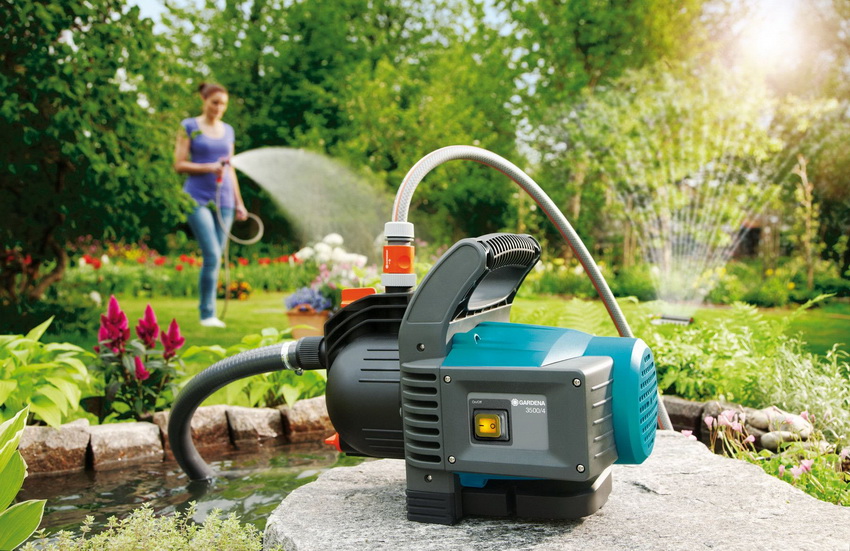
If water is taken from a reservoir or tank, then it is advisable to buy a pumping unit for arranging an autowatering system
For the organization of drip irrigation, the most suitable option is a centrifugal pump unit. The vane type is more reliable and expensive, which can have a vertical or horizontal wheel arrangement. Such a pump is used for sprinkling. If the water flow rate exceeds 2 l / s, it is better to install a piston centrifugal unit.
For large areas, when creating automatic sprinkling, it is recommended to give preference to an axial pump. For drip irrigation of a large area, it is advisable to install a vortex unit.
Selection of pipelines for organizing an automated irrigation system in the country
Pipes are used to ensure the movement of water from the reservoir to the destination. They are connected to the main water pipeline. Elements are stacked for each section separately and connected to valves and sprinklers.
Pipelines can be metal and plastic. The first option is characterized by high strength and performance characteristics. However, metal products are prone to corrosion, which reduces their service life. Also characteristic of the material is laborious installation, which requires certain skills and abilities.
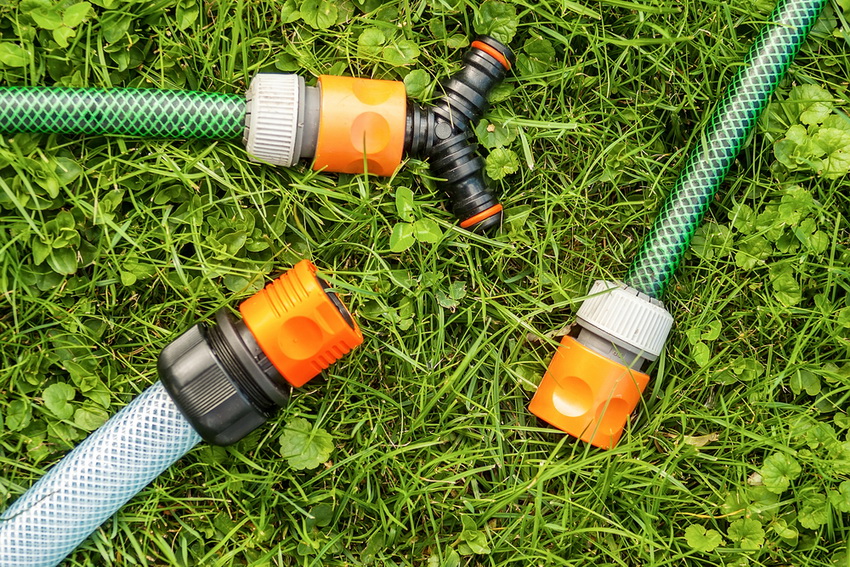
Plastic pipes are of the highest quality and therefore a suitable option for automatic irrigation systems.
A more practical option for arranging an automatic watering system with your own hands is plastic products. The material has a smooth inner surface that eliminates the possibility of deposits accumulation, thereby reducing the throughput of pipelines. Polyethylene pipes are resistant to temperature fluctuations, corrosive substances and solar radiation. Such a strong and durable material can be laid underground and on its surface.
Installation of individual elements is carried out using soldering or fittings. The cost of products is 40-80 rubles / m. Among the well-known manufacturers, the preference should be given to Wavin, Rehau and Ostendorf.
More economical, but no less reliable, are polypropylene pipelines. Products are distinguished by good strength characteristics and long service life.These pipes should be bought from such well-known manufacturers as Aquatherm, Rehau, Wefatherm, Banninger, Ekoplastik, Pro Aqua, Valtek, Santrade, at a price of 30-50 rubles / m.
Varieties of automatic watering schemes for the garden
There are several variations of automatic irrigation schemes that can be seen on the Internet. All of them are mobile and are selected based on the characteristics of the territory and types of green spaces. The most popular option is a water supply scheme where a pumping station is used. Water from the source is pumped through pipelines and supplied to the plants using sprinklers or in the form of drops. A filter is installed after the pump.
You can provide a node for fertilizing. It consists of a container, an injector and shut-off valves. Such a device will certainly come in handy when organizing an autowatering system for greenhouses, vegetable gardens and gardens. The solution is supplied to the pipeline using an injector. The number of irrigation lines is determined based on the nature of the planting and the pressure in the network. The choice of droppers or sprinklers is carried out by calculating the water flow required for watering plants.
For the organization of autowatering for flowers and lawn, a sprinkler irrigation scheme is acceptable. It can also be used in the country, watering low-growing plantings, the height of which is 10-15 cm. In this case, the pipelines are laid underground so as not to create obstacles when mowing the lawn. The sprinklers can also be located in the ground and extend at the start of the system. Autowatering can work without a pump unit. Water is supplied by gravity, which is most often used for drip irrigation.
Features of rain automatic irrigation
Rain irrigation is mainly used for watering lawns, strawberry plantations and large areas with their own hands. This system can be installed in greenhouses for crops that like a humid microclimate. Sprinkling water, which is dispersed by the sprinklers, gets under the root and on the ground part of the plant.
Related article:
Do-it-yourself drip irrigation for a summer residence without costs: do it yourself easily and simply
How to equip drip irrigation in the country yourself from ready-made components or improvised materials. Features of installation.
The sprinkler system can be laid by air or subsoil. The latter option is more accurate and durable. It is installed with confidence in the permanent location of green spaces. Sprinklers with nozzles are also located underground. At the moment when the pressurized water system starts to work, the sprinkler moves up, supplying water to the site. When organizing an autowatering rain system for greenhouses, an air method of laying communications is used.
Important! Sprinkling can operate at a water pressure in the pipeline of at least 2 atm.
The system can be connected to a centralized water supply pipeline or take water from a barrel. The latter option involves the installation of a pump, the operation of which is controlled by the controller.
The main advantages of the system are the following factors:
- promotes gradual uniform absorption of moisture;
- humidifies the air, which is especially important in greenhouses;
- washes leaves and fruits of shrubs and trees from dust and insects.
The disadvantages of the sprinkler system include the formation of a crust on the surface of the earth, which prevents oxygen from entering the soil. In addition, such automatic watering requires a lot of water and electricity.Constant imitation of rain can be detrimental to some crops due to the fact that it contributes to the development of various diseases. However, this is the most rational system for automatic irrigation of lawns and beds with frequent plantings.
The automatic sprinkler system consists of a pump, hoses and special spray nozzles that spray water around itself in a certain radius. Sprinklers for watering the garden can be fan or rotary. The first option is suitable for a small area. The operating radius of such sprinklers is up to 5 m. The fan-shaped sprinklers can be equipped with different nozzles, thanks to which the irrigation sector is regulated.
To moisten large areas, it is better to choose rotary sprinklers, which, dynamically rotating around their axis, spray water over long distances - up to 10 m. For root watering, the system can be equipped with bubblers. Do not install different types of sprinklers in the same area, as they provide different irrigation rates.
Useful advice! For irrigation of roadside lawns, the do-it-yourself irrigation system is completed with fan sprinklers that work in one direction.
Preparatory stage before installing an automated sprinkler system
Before doing autowatering, you should draw a detailed plan with the application of all buildings, garden paths, beds and green spaces. The site is divided into zones and the locations of the sprinklers are marked. For corner installations, sprinklers should have a 90 ° radius and 360 ° over the entire area.
Useful advice! Sprinklers are positioned in such a way that the intersection of the radii of the coverage of the installations is ensured.

Sprinklers must be selected and installed based on the throughput of pipes and the size of the section
Next, a piping system is applied, the location of the pump is indicated relative to the selected irrigation source. When determining the number of sprinklers, one should take into account the fact that the least water flow is ensured at the location of the device itself. Most of it ends up on the ground far from the equipment.
The next step is to determine the required pipe diameter. Based on experience, many experts recommend laying pipes with a diameter of 40 mm on a site of 1 hectare, the throughput of which is 50 l / min.
It is recommended to install the self-watering system of the lawn with your own hands in the fall in order to admire the green plantation in the spring. To lay the main and outlet pipes underground, a trench should be dug 30-40 cm deep, if the earth will not be plowed here in the future. Otherwise, the depth should be at least 50 cm. A crushed stone pillow is laid at the bottom of the trench, which will act as a drainage. If an air installation is expected, then it is required to prepare supports and fasteners for installation to the roof.
Important! It is imperative that when organizing autowatering in a greenhouse with your own hands, a compensation loop should be provided, which is necessary in the case of bends and linear changes in the size of the hoses at different temperatures.
Do-it-yourself rain autowatering: a sequence of actions
Installation of automatic irrigation begins with the laying of main pipes. At the branch points, the pipe is cut off, a tee is installed to connect the hose, which will divert water to the sprinkler. An articulated elbow must be attached to the end of this branch so that the height of the sprinkler will be adjusted. All sections of the system are mounted in the same way.
The next step is to install the nozzles in the sprinklers.To do this, unwind the glass, remove the upper part, compress the spring on the sprinkler and insert the nozzle into a special hole. It needs to be pressed lightly to enter the sprinkler itself. To check the correct position of the nozzle, release the spring. If the element has risen to the very top, then it is installed correctly. Next, you need to tighten the nozzle screw clockwise with a special wrench.
Sprinklers can now be attached to the articulated arms. Then trenches should be buried, leaving the locations of the sprinklers. Sprinklers must be level with the ground by operating the articulated knee. Next, the sprinklers are buried. The ground around the elements must be carefully tamped.
Important! The top of the sprinkler should be no higher than the bottom level line that is on the ground.
Then the solenoid valve is installed in the direction of fluid movement, as indicated by a special arrow on the device body. The pipeline from the valve to the water supply system or pumping station is being connected. A software controller is mounted, thanks to which you can automate the system by configuring its operation in a specific mode. The entire system is tested for operability.
Drip irrigation as a type of automatic irrigation system in the country
The drip irrigation for the garden and garden is the most popular type of irrigation today. It is advisable to arrange it in small areas with parallel planting of plants. This is the most economical irrigation option, since water is supplied to garden crops by drip method. It is advisable to arrange such automatic watering at low pressure in the irrigation system.
A storage tank with water, located at a certain height, is used as a source of water supply. A main pipeline is supplied to the tank, which leads water to the distribution hoses, laid parallel to each other. Do-it-yourself automatic drip irrigation is used for berry and vegetable garden crops, shrubs, trees and flowers. This system is often installed in small greenhouses, flower beds and vegetable gardens.
Today it is possible to buy a ready-made kit, which necessarily includes a timer, sensor, pressure gauge and thermometer, and you can also complete the system yourself. This will require a ¾ or 1 inch main pipeline and thin-walled hoses with mini-holes in the structure. For these purposes, it is recommended to purchase an oozing element type. Hoses are laid along each row of crops on the surface of the soil. You should also stock up on a mesh filter and a timer or controller for autowatering.
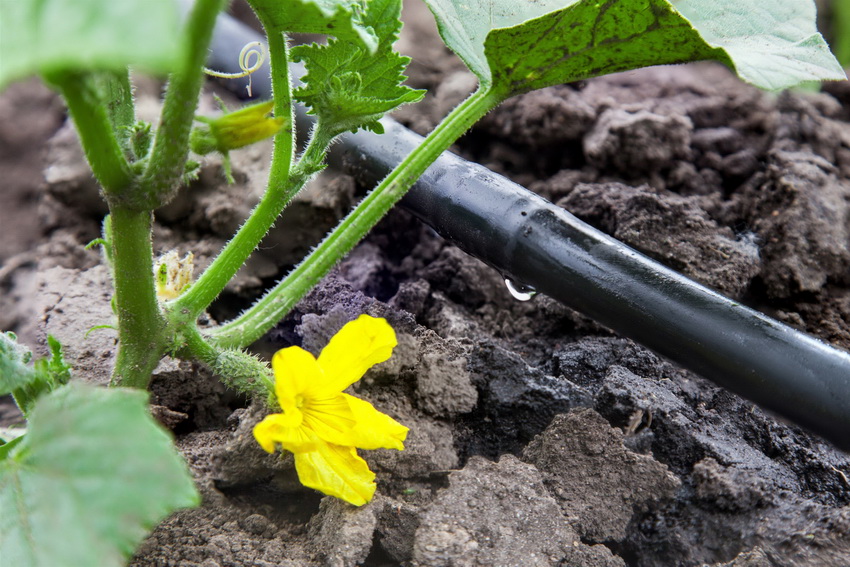
Drip irrigation usually used to moisturize the root zones of the plant
The design of an automatic irrigation system is based on a previously developed scheme. At the first stage, a line is laid with some downward slope for subsequent cleaning and draining of the system for the winter. Parallel branches are made using fittings. The ends of the hoses must be closed with plugs.
Useful advice! It is recommended to place hoses and pipes on the ground on special supports or pegs.
A container of a certain volume is used as a source of water supply for drip irrigation, which is selected based on the number of green spaces. A filter is installed at the outlet of the tank, then a controller or a timer. Next, the main pipeline is connected. After completing the installation of the system, it is tested. Then set the timer or controller to the frequency and duration you want to water.

To distribute water, the main pipe is connected to the tank, from which branches follow to the irrigation points
Organization of subsoil watering for the garden
The subsurface irrigation system is used in small suburban areas. It is also advisable to arrange it for greenhouses. This is a fairly economical option that does not need a large water pressure in the system and can work safely due to the height difference between the two communicating tanks. Underground root irrigation ensures minimal water loss and prevents evaporation.
The disadvantage of a do-it-yourself subsurface irrigation system is the likelihood of quick clogging and labor-intensive installation. It is problematic to arrange intra-root autowatering on a planted plantation, since it is possible to damage the root system of green spaces.
It is convenient to organize such watering for perennial plants that need constant moisture. Water at a comfortable temperature reaches the roots slowly and evenly, which contributes to the constant maintenance of moisture in the soil.
The installation of the system is carried out in the same way as the above options for autowatering. Here you will need a plastic or metal pipe for the main pipeline, a perforated hose for branches, a pump, a controller and a filter. The pipes are laid in a pre-prepared trench with a plastic wrap laid at its bottom.
A pump is connected to the storage tank. Next, the filter and controller are installed, and the main pipeline is connected. Do-it-yourself automation of the garden watering system consists in turning on and off the pump unit at a certain time. The following parameters are optimal for subsurface irrigation: head - 0.3 m, water velocity - 0.2 l / s. 3-4 days after starting the system, it is necessary to excavate the soil in several places and check the degree of its moisture.
Which is better to buy automatic irrigation for greenhouses: an overview of popular kits
Those who do not want to engage in independent selection of elements for the irrigation system can buy ready-made automatic irrigation. One of the most popular options for drip irrigation is the Aquadusya system. It is designed for an area of up to 5 m². The maximum watering time is 1 hour.

Automatic irrigation systems have sensors that measure humidity and therefore turn off when it rains
The kit includes hoses, drippers and a controller that runs on conventional batteries. With the help of "Aquadusi" you can organize watering for 50 plants. The system is easy to use and can be assembled independently, without the involvement of specialists, which is carried out on the basis of the detailed instructions that come with the product. The service life of autowatering is at least 5 years. The system can be purchased for 5400 rubles.
Another popular model of automatic irrigation for greenhouses, which can be bought for 6500 rubles, is the Beetle set. The name of the root drip system comes from the appearance of the location of the hose, which resembles an insect. The model is characterized by a simple design that even a novice master can assemble. The system is designed to water 60 plants in an area of 18 m². But there is also a greenhouse option, designed for 30 plants on an area of 6 m².
Useful advice! The system can be increased by additionally purchasing irrigation lines from the store.
Auto-irrigation "Beetle" consists of main pipelines and small branches, located in pairs opposite each other, at the ends of which there are sinusoidal droppers, which prevents clogging. The set may not include a timer, which requires additional purchase of the device.The system is equipped with a filter that automatically cleans water from mechanical impurities. Automatic irrigation is connected to the tap of the centralized water supply network or to a water barrel, which is usually located at a height of up to 4 m. Watering can last up to 2 hours with an interval of 1 to 160 hours.
Description of options for automatic lawn irrigation systems
The leading position among manufacturers of automatic irrigation systems is occupied by the Hunter company, which offers a wide range of accessories for irrigation both small areas and commercial areas. In the manufacturer's catalogs, both ready-made fully automated high-performance irrigation systems are presented, as well as various devices designed for self-assembly of the circuit. You can buy an automatic irrigation system designed for 20 m² on average for 50,000 rubles.
Sprinklers are presented in two types: fan and rotary. The first option has a simple design and a simple operating principle. Nozzles for such products are made of high-quality plastic, therefore they are characterized by durability and reliability. Round, striped, adjustable and non-adjustable elements are available for fan-shaped sprinklers. Rotary sprinklers are complex in design. The water flow is controlled by the special position of the head, which is determined by the required radius. Irrigation with sprinklers can be carried out on an area with a length of 1 to 30 m.
Hunter Auto Irrigation Controllers and Sensors perform different tasks that are defined during the programming phase. The devices are powered from the mains or batteries. Control elements can be selected for both outdoor and indoor installation.
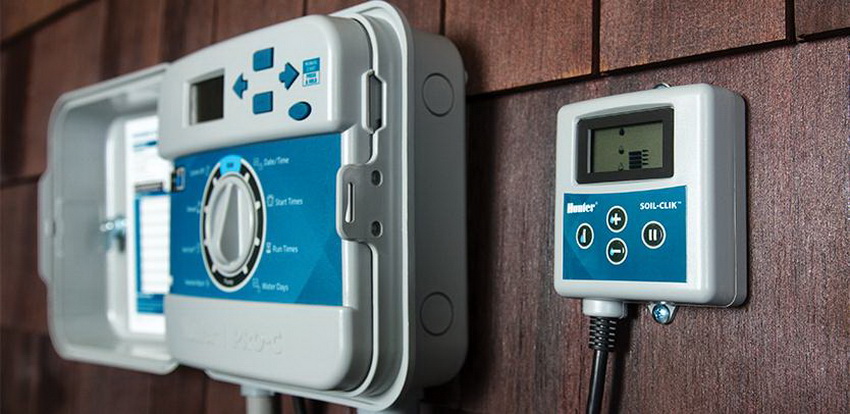
An advanced automatic irrigation control system allows you to programmatically control all functions
An equally popular irrigation system is the Gardena autowatering. The complete set includes a controller, polyethylene piping and sprinklers. The system is designed for irrigation of areas up to 380 m². This is done thanks to retractable turbo sprinklers, on which the irrigation range is regulated.
The controller is equipped with a rain and humidity sensor, as a result of which the humidity conditions of the environment and soil are checked. The price of automatic irrigation for 20 m² is 60,000 rubles.
The organization of an automatic irrigation system for a vegetable garden, garden, lawn or greenhouse allows you to rationally use water and at the same time saturate the soil with the necessary amount of moisture, which is required for the normal growth of green spaces. Depending on the type of plants and the area of the territory, you can independently organize one of the varieties of the autowatering system, which is most suitable for specific conditions, having studied in detail the features of its installation.
